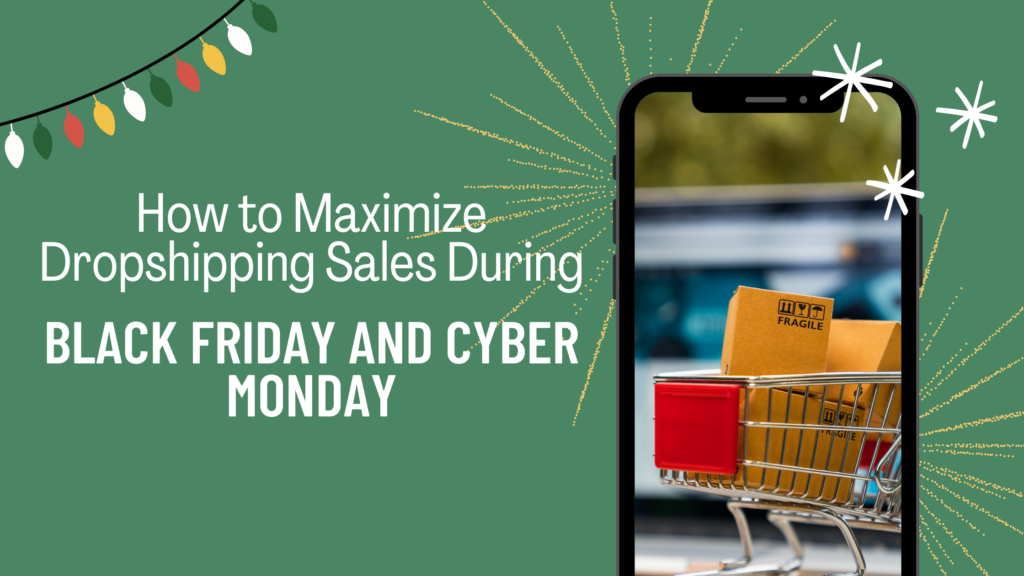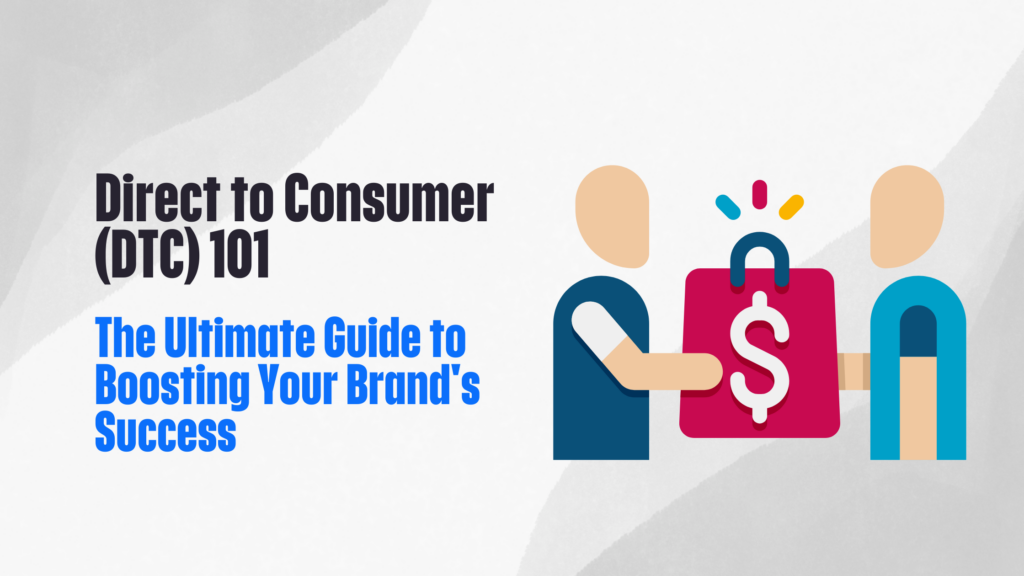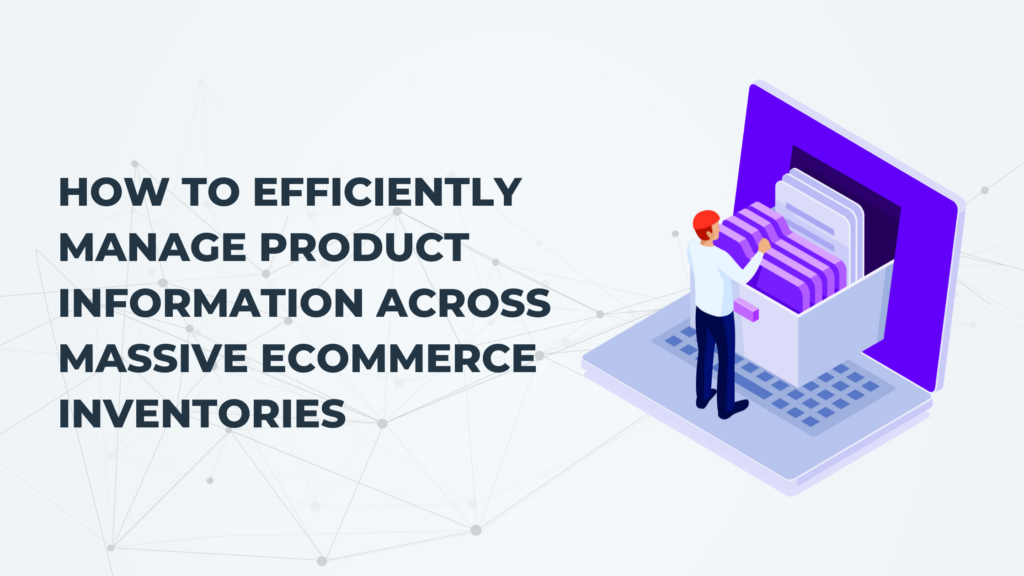How to Maximize Dropshipping Sales During Black Friday and Cyber Monday
Black Friday and Cyber Monday are two shopping events that bring massive online traffic and eager buyers looking for deals. For dropshippers, it’s the perfect time to boost sales, attract new customers, and drive profits. The surge in demand allows businesses to clear out inventory while also introducing new products to the market. To maximize success, dropshipping businesses must prepare well in advance with effective sales strategies and promotions. Strong customer retention strategies during these events can also lead to long-term loyalty. With the rise in online shopping trends, especially around Black Friday dropshipping and Cyber Monday sales, it’s essential to have a solid plan to stand out from the competition. By understanding these sales peaks, you can capture a significant share of the market and grow your business rapidly.
Preparing Your Store for the Holiday Rush
As Black Friday and Cyber Monday approach, the surge in online shopping presents a huge opportunity for dropshipping businesses. However, to fully capitalize on this, it’s important to ensure your store is well-prepared for the holiday rush. The key to success lies in optimizing your website, updating product listings, and incorporating holiday-themed designs. Here’s how you can get your store ready for the busiest shopping days of the year:
Optimizing Website Performance
With the significant traffic spikes expected during Black Friday and Cyber Monday, your website’s performance becomes more critical than ever. Shoppers demand a fast, seamless experience, and any delays or hiccups can result in missed sales. Here are some strategies to ensure your site runs smoothly:
- Speed Matters – A slow website can cause frustration, leading to abandoned carts and lost revenue. Aim to reduce page loading times by optimizing images, minimizing unnecessary plugins, and using a reliable hosting provider that can handle increased traffic. Studies show that even a one-second delay in loading can decrease conversions by 7%, which can be costly during a high-volume period like Black Friday dropshipping.
- Mobile Optimization – With mobile devices accounting for a large portion of online shopping trends, it’s essential that your website is fully optimized for mobile users. Ensure your layout, product pages, and checkout process are mobile-friendly, providing a smooth experience no matter the device. An easy-to-navigate mobile site can significantly increase your chances of capturing sales.
- Streamlining the Checkout Process – A complicated checkout can drive customers away. Simplify the process by reducing the number of steps required to complete a purchase. Enable guest checkouts, provide multiple payment options, and ensure that auto-fill forms work correctly. Offering free shipping or clearly displaying shipping costs upfront can also encourage buyers to complete their orders.
- Testing Site Resilience – Before the big days, test your website under heavy loads. Use tools that simulate traffic surges to identify weak points and fix them. This proactive approach helps you avoid unexpected downtime during Black Friday or Cyber Monday when every minute counts.
Updating Product Listings
Effective product listings are key to grabbing the attention of holiday shoppers. Updating them with relevant information, competitive pricing, and clear descriptions can make all the difference. Here’s what to focus on:
- Highlight Discounts and Deals – Update product titles and descriptions to emphasize any Black Friday or Cyber Monday discounts. Use keywords like “limited-time offer” or “holiday sale” to entice shoppers.
- Enhance Product Descriptions – Provide detailed, accurate descriptions that address customer needs. Focus on benefits, especially if products are ideal for holiday gifts.
- Add High-Quality Images – Ensure your product images are clear and professional, and showcase the items in the best possible light. Consider adding festive backgrounds or special badges like “holiday bestsellers.”
- Optimize for Search – Use relevant SEO strategies for your product listings, especially terms related to Black Friday dropshipping and Cyber Monday sales strategies. This ensures your products appear in search results when customers are actively shopping.
- Update Inventory Levels – Make sure your inventory data is current to avoid overselling popular items. You don’t want to disappoint customers with out-of-stock notifications after they’ve made a purchase decision.
Setting Up Holiday-Themed Designs
A visually appealing store that reflects the festive spirit of Black Friday and Cyber Monday can enhance the customer experience and increase conversion rates. Shoppers are more likely to engage with a website that feels in tune with the holiday season. Here’s how to add that holiday touch:
- Seasonal Banners and Graphics – Design holiday-themed banners that promote special offers, discounts, and exclusive deals. You can place these on the homepage, category pages, and even within the product listings. Bold, festive colors like red, green, gold, or blue tend to catch attention during this time of year. Don’t forget to include key messaging about your Black Friday or Cyber Monday promotions in these graphics.
- Holiday-Themed Pop-ups – Use pop-ups to capture visitors’ attention when they land on your site. Promote limited-time offers, free shipping, or bundle deals specifically for Black Friday dropshipping shoppers. Make sure the design is cohesive with the rest of your holiday theme and doesn’t feel intrusive. Timing is essential—avoid interrupting the browsing experience too early.
- Customizing the Checkout Experience – Add holiday-themed touches to your checkout page. Whether it’s a festive color scheme, a countdown to the end of the promotion, or a “gift-wrapping” option, these small details can enhance the buying experience and create urgency. This also reinforces the holiday excitement for customers, driving them to complete their purchases faster.
- Product Pages with Holiday Cheer – Update your product pages with festive elements. You can add holiday decorations, like snowflakes, twinkling lights, or small gift icons next to products. Ensure these decorations don’t overshadow essential information like pricing or product details, but still bring a sense of festivity to the overall design.
Creating Irresistible Offers
Structuring Discounts and Deals
To maximize dropshipping sales during Black Friday and Cyber Monday, structuring your discounts and deals effectively is crucial. These shopping events are known for huge sales, so offering compelling discounts can make your store stand out. Start by setting discounts that attract attention but still keep your profit margins in mind. Consider a tiered approach, where customers unlock higher discounts when they spend more. For example, you could offer 10% off for orders over $50 and 20% off for orders over $100. This encourages shoppers to spend more, boosting your average order value.
Another strategy is to create product-specific discounts. Offer significant markdowns on high-demand items or seasonal products to draw traffic to your store. Highlight these discounts on your homepage and through your marketing channels. This tactic is especially powerful during Black Friday dropshipping when customers are looking for the best deals. Ensure that your discount codes are easy to apply, and promote them heavily to avoid cart abandonment.
Bundle Offers
- Bundle complementary products together to increase the perceived value. For example, if you sell phone cases, bundle them with screen protectors at a discounted rate.
- Offer buy-one-get-one (BOGO) deals to encourage higher purchase volumes. Shoppers feel like they’re getting more for their money.
- Ensure that your bundles offer a discount compared to buying the items separately. This way, customers see the added benefit and feel more inclined to complete the purchase.
Limited-Time Promotions
- Create urgency by offering time-sensitive discounts, such as flash sales lasting a few hours or “early bird” specials for the first 100 customers.
- Display countdown timers on your website to emphasize the limited-time nature of the promotion. This pushes hesitant buyers to make quicker decisions.
- Promote limited-time deals through email campaigns and social media. Remind your audience that these offers won’t last, which taps into online shopping trends and fuels impulse buying behavior.
Marketing Strategies
To make the most of Black Friday and Cyber Monday, it’s essential to have strong marketing strategies in place. These shopping events create massive opportunities for dropshippers to boost sales. Let’s explore some effective tactics, including email marketing campaigns, social media promotions, and influencer partnerships, to maximize your revenue during these high-traffic periods.
Email Marketing Campaigns
Email marketing is one of the most powerful tools to drive conversions during Black Friday and Cyber Monday. It helps build anticipation, remind customers about deals, and keep your brand at the top of their minds.
Segment Your Audience:
- Break your email list into smaller groups based on purchase history, customer interests, or shopping behavior.
- Tailor your content to resonate with each segment, offering personalized discounts or product recommendations.
Create Urgency:
- Use countdown timers in your emails to build urgency. Phrases like “limited time offer” or “only a few hours left” encourage quick action.
- Include clear, attention-grabbing calls-to-action (CTAs) like “Shop Now” or “Claim Your Discount.”
Highlight Best-Selling Products:
- Promote top products and bundle deals that offer value to customers. This can encourage shoppers to purchase more items.
- Focus on products that have previously performed well during major sales events.
Schedule Multiple Emails:
- Start with a “warm-up” email days before Black Friday or Cyber Monday to introduce your upcoming promotions.
- Send a “live now” email as soon as your sale begins, followed by reminders during the sale.
- Finish with a “last chance” email to capture any remaining shoppers before the sale ends.
Optimize for Mobile:
- Ensure all emails are mobile-friendly, as a significant portion of Black Friday and Cyber Monday shoppers browse and purchase on mobile devices.
Follow-Up After the Sale:
- Send post-purchase emails to thank customers for their orders and offer loyalty discounts for future purchases.
- This enhances customer retention strategies, encouraging repeat business even after the holiday season.
Social Media Promotions
Social media is essential for building awareness and driving traffic during Black Friday and Cyber Monday. These platforms help engage with your audience and increase brand visibility.
Create Teaser Campaigns:
- Begin promoting your deals early with teaser posts on platforms like Instagram, Facebook, and Twitter.
- Share sneak peeks of the discounts, and countdowns to the sale, and engage with your audience through polls or interactive content.
Leverage Paid Ads:
- Invest in targeted ads on platforms like Facebook and Instagram to reach a broader audience.
- Use ad targeting to focus on specific demographics, interests, and behaviors that align with your target customer base.
Utilize Stories and Reels:
- Instagram Stories, Facebook Stories, and TikTok are highly effective for promoting flash sales or limited-time offers.
- Use these features to create engaging, time-sensitive content with swipe-up links leading directly to your product pages.
Run Contests or Giveaways:
- Offer contests or giveaways leading up to Black Friday or Cyber Monday to increase engagement and grow your follower base.
- Encourage users to share your posts or tag friends, boosting your reach organically.
Use Hashtags and Trending Topics:
- Incorporate popular Black Friday and Cyber Monday hashtags to increase visibility.
- Stay updated with online shopping trends and use them in your social media copy to attract more attention.
Offer Exclusive Social Media Discounts:
- Provide special discount codes for your social media followers that aren’t available elsewhere.
- Announce these exclusive offers through live sessions, Stories, or posts to encourage engagement.
Influencer Partnerships
Partnering with influencers can significantly boost your brand’s exposure and sales, especially during the holiday shopping rush. Influencers can introduce your products to new audiences and create authentic connections with their followers.
Identify Relevant Influencers:
- Look for influencers within your niche who align with your brand’s values and have an engaged audience.
- Choose micro-influencers or macro-influencers based on your budget and the type of campaign you wish to run.
Create a Clear Partnership Plan:
- Work with influencers to develop a Black Friday or Cyber Monday promotional plan that includes product reviews, unboxing videos, or limited-time discount codes.
- Provide influencers with exclusive discounts for their audience, encouraging followers to act quickly.
Leverage Multiple Platforms:
- Use influencers across various platforms, including Instagram, YouTube, TikTok, or even blogs. Each platform offers different ways to showcase your products and deals.
- Have influencers create engaging content such as tutorials, shopping hauls, or “best deal” videos featuring your products.
Track Performance with Unique Codes:
- Provide influencers with custom discount codes so you can track the exact sales generated from their campaigns.
- This allows you to assess the return on investment (ROI) and optimize future collaborations.
Collaborate on Giveaways or Flash Sales:
- Have influencers promote giveaways or flash sales exclusively for their followers, generating excitement and urgency.
- These promotions can drive high volumes of traffic to your store during Black Friday and Cyber Monday.
Optimizing for Mobile Shopping
Nowadays, mobile responsiveness is essential for maximizing Black Friday dropshipping and Cyber Monday sales. With more customers using smartphones to browse and shop, your website must perform seamlessly on all devices. Mobile-responsive design ensures that your site automatically adapts to any screen size, providing an optimal shopping experience.
This means images, buttons, and text should be easily viewable and clickable on smaller screens. Customers expect fast loading times, easy navigation, and a clean interface. A poorly designed mobile site can cause frustration, leading to abandoned carts and missed sales opportunities. By focusing on mobile responsiveness, you can capture the growing number of mobile shoppers, increasing your chances of success during peak shopping events like Black Friday and Cyber Monday.
Test your website’s responsiveness by simulating various screen sizes and ensuring your product pages are engaging on mobile devices. This attention to detail builds trust and encourages more conversions, supporting your customer retention strategies.
Streamlining the Mobile Checkout Process
- Simplify Navigation – Ensure your checkout process is easy to navigate on mobile. Reduce the number of clicks required to complete a purchase.
- One-Click Payment Options – Enable one-click checkout or guest checkout options to make the process quick and frictionless for returning and new customers.
- Auto-Fill Features – Use auto-fill options for address and payment details to speed up the checkout process and minimize customer effort.
- Mobile-Friendly Payment Gateways – Integrate mobile-friendly payment options such as PayPal, Apple Pay, or Google Pay to cater to a wider audience of mobile users.
- Clear Progress Indicators – Provide visual indicators showing the customer how far they are from completing the checkout process, keeping them engaged and reducing cart abandonment.
- Fast Load Times – Optimize your checkout pages for fast load times. Mobile users expect speed, and a slow checkout process could lead to higher bounce rates.
- Minimal Information Required – Ask for only essential information to make the checkout as quick and painless as possible, enhancing the customer experience.
- Mobile Security – Use secure payment gateways with SSL certificates to ensure customer confidence in your site’s security, especially when dealing with Black Friday dropshipping and high sales volumes.
Customer Service Preparation
During Black Friday and Cyber Monday, scaling up customer service is essential to ensure smooth operations and maintain customer satisfaction. With the massive increase in traffic and orders, your dropshipping business must be equipped to handle customer inquiries efficiently. Below are two crucial strategies for preparing your customer service team for the shopping rush:
Scaling Up Customer Support
- Hire Temporary Support Staff – As sales volume surges during Black Friday dropshipping, having more support agents can help manage the influx of customer inquiries. Temporary staff can assist with answering basic questions and resolving common issues quickly.
- Extend Support Hours – Black Friday and Cyber Monday are peak online shopping days, and customers may need help at any time. Extending support hours ensures that customers can reach your team, even outside typical business hours.
- Train Your Support Team – Make sure your customer service team is well-versed in handling dropshipping issues. Provide specific training on dealing with out-of-stock items, delayed shipments, and other common problems during sales events.
- Utilize a Ticketing System – A ticketing system allows you to organize and prioritize customer inquiries. During busy periods, this can be vital to ensure no customer gets overlooked, improving customer retention strategies and overall satisfaction.
Implementing Chatbots
- 24/7 Availability – Chatbots can offer instant support, even when your human agents are unavailable. Implementing chatbots allows customers to receive immediate responses to common questions, such as tracking their orders or checking stock availability.
- Reduce Response Times – Fast customer support is crucial, especially during high-traffic sales like Black Friday and Cyber Monday. Chatbots help reduce response times by handling simple inquiries, allowing your human agents to focus on more complex issues.
- Automate Common Questions – Chatbots can be programmed to answer FAQs, such as shipping policies, returns, and product details. This automation reduces the load on your support team and ensures that customers get quick answers.
- Improve Customer Experience – Chatbots help streamline the support process, ensuring customers feel valued. A smooth, fast customer experience enhances customer loyalty and encourages repeat business during online shopping trends.
Post-Sale Strategies
Follow-up Marketing – After the Black Friday and Cyber Monday rush, follow-up marketing is key to keeping customers engaged. Send personalized thank-you emails or offer exclusive discounts to encourage repeat purchases. Retargeting ads and social media campaigns can remind buyers of items they viewed or left in their carts. Use these opportunities to promote new arrivals or upcoming sales. By staying on your customers’ radar, you build long-term relationships that go beyond the holiday shopping season. Following up after the sale helps maintain momentum and boosts customer retention.
Encouraging Reviews – Positive reviews are powerful tools in increasing trust and driving future sales. After the purchase, ask customers to share their experiences. You can incentivize reviews by offering discounts on their next order or entry into a giveaway. Make it easy by providing a direct link to review platforms or your website. Good reviews not only enhance your store’s credibility but also influence new customers during future Black Friday dropshipping and Cyber Monday sales. Encouraging reviews builds a strong online reputation that lasts long after the shopping season ends.
FAQ
How early should I start preparing for Black Friday and Cyber Monday?
Start preparing for Black Friday dropshipping and Cyber Monday sales strategies at least 2-3 months in advance to align with online shopping trends and boost customer retention strategies.
What types of discounts work best for dropshipping?
Percentage discounts, buy-one-get-one offers, and free shipping work best for dropshipping. These align with Black Friday dropshipping and Cyber Monday sales strategies, boosting customer retention.
How can I handle potential shipping delays during the holiday season?
Communicate shipping deadlines clearly, offer faster shipping options, and keep customers updated on order status. Use customer retention strategies to manage expectations during Black Friday dropshipping.
What are some effective ways to stand out from competitors during these sales events?
To stand out during Black Friday dropshipping and Cyber Monday sales, offer exclusive discounts, create urgency with limited-time deals, use personalized marketing, and focus on customer retention strategies.
How can I leverage social proof during Black Friday and Cyber Monday?
Use customer reviews, testimonials, and social media shares to show popularity. Highlight positive experiences to boost trust during Black Friday dropshipping and Cyber Monday sales strategies.



